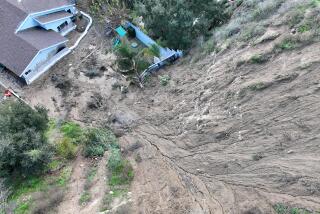Chalk Up Another One for the River
- Share via
MODESTO, Calif. — The Gagos family did not easily give up their home of 35 years to the great New Year’s week floods. They fought through the night to stop the brown water creeping across their backyard.
They filled sandbags nonstop, helped by friends who hauled in truckloads of sand and empty sacks. “We worked like dogs putting those on the outside,” George Gagos said Saturday.
“But then my daughter looked down and noticed that water was coming in through one of the vents under the house.”
Score another one for the river.
The Tuolumne River is usually Modesto’s best friend, but on Saturday it rose to its highest flood level ever recorded. Such civic milestones are painted on the 9th Street bridge, which displays the (previous) record flood as 69.2 feet on Dec. 9, 1950.
Early Saturday morning, the river crested at 70.9 feet, and by nightfall had fallen a few scant inches, leaving the Gagoses and nearly 3,000 of their neighbors temporarily homeless.
The water was pouring out of Don Pedro Dam, which was built in 1971 and until this week had never spilled a drop of flood water. On Saturday, it was disgorging a torrent, trying to stay ahead of the runoff cascading from the saturated Sierra.
The Gagoses’ backyard was under a large muddy lake, the surface broken only by trees, floating lawn furniture and storm debris. At the flood’s peak, the Gagoses’ two freshly remodeled basement rooms were completely underwater and the main floor submerged shin-deep.
The family had time to save furniture and valuables before fleeing to high ground early Saturday. Now the house belonged to the river.
“We’ve lived here 35 years and we’ve been through a couple of pretty major floods. But it’s never been like this,” lamented Dianne Gagos.
When the family built the house, they raised it a foot above the 100-year flood level. “But what does that mean?” she asked with a chuckle. “It doesn’t really mean anything.
“We’re dazed. But you know what? We feel really, really lucky. Because we so easily could have a houseful of mud. Instead we have what looks like clear water. I guess the sandbags must have filtered out the muck.”
She praised friends, family and neighbors--about 10 of them--who helped empty the house before the flood waters washed in. “An old Cub Scout who I haven’t seen in 20 years came wandering by and said, ‘Can I help?’ ” she said.
In all, more than 2,500 residents of Stanislaus County were forced out of their homes by flood waters. A health warning was issued for Modesto because the city’s sewage treatment plant was inundated, washing raw effluent into the water coursing through town.
Julia Furr joined more than 300 refugees on borrowed cots at the Red Cross shelter at Modesto High School. She had 90 minutes of notice to leave her new residence in the Del Rio mobile home park beside the Tuolumne. She and her sons had moved there in August.
“I’ve been up the last two mornings at 3:30 worrying about the river,’ she said. “I’m just thankful we’re alive. I cried and I cried because we’re on a fixed income, and when we got our back SSI checks, we each went out and bought something special.”
When the water rose, she said, “I felt stunned because I had all my stuff still there. We had a new love seat, a new couch, a new TV, a new bed, and I lost so many clothes. We just took a few things and left.”
Phyllis Sherman said the rising water also caught her by surprise. “It makes you rethink where your priorities are,” she said. “You can step back and think one step at a time, and you can get through it and deal. But you feel a lot of your stress go up.”
In the Rose Lawn section of the city, Alex Owens and his girlfriend, Lashawn Dean, watched the water creep across the golf course between the river and their house. “It kind of shocked me,” Owens said. “I had never seen that before.”
“It’s kind of scary to see the water rising up to my house like that,” Dean said. “We don’t know what the damage is to our house, and they say we can’t go back in for two or three days.”
Modesto police were patrolling the city to keep looters from breaking into vacated homes. Teams will go house to house checking for gas leaks and electrical services before letting people go home, possibly Sunday.
“The water seems to be flattening out and maybe even receding a little,” said Russ Richards, assistant director of emergency services for Stanislaus County. “We are trying to get people to their homes as best as we can.”
Although the Tuolumne had dropped slightly by Saturday night, emergency officials were concerned about what could happen when the high flow collides downstream with the raging San Joaquin River.
The fear was that the meeting of the two rivers near the town of Vernalis would put new pressure on levees protecting towns and farmland.
More to Read
Sign up for Essential California
The most important California stories and recommendations in your inbox every morning.
You may occasionally receive promotional content from the Los Angeles Times.













